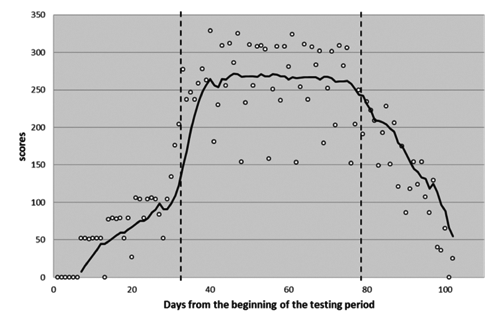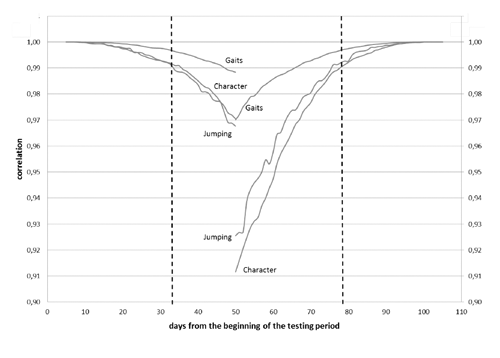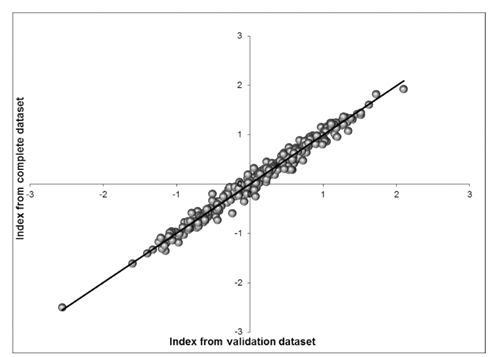Abstract
The Sella Italiano stallions are selected by 100-day perfomance test, but many breeders organisations use station test of shorter length. In twelve editions, 17,394 ten-point scores both for character and gaits, and 6291 scores for jumping were assigned to 314 candidate stallions. By means of the comparison of univariate EBVs, calculated from the complete dataset or from the reduced subsets, a dataset lasting only from 33rd day to 78th day of the training period was selected: it included less than 70% of the original data. The subset was validated by 3-trait AM BLUP: there were no evident effects on the estimates of variance component or ratio, and the aggregated selection index for the three traits showed a 99% rank correlation with the official index. These findings demonstrate that the training period could be reduced without affecting the genetic progress in the Sella Italiano breed.
Introduction
The European organisations use three different types of data to select stallions for show jumping: competition data, field test and station performance test (Bruns et al., Citation2001; Thorén Hellsten et al., Citation2006). Field test traits usually show a lower heritability than station test traits, but the field test counteracts the heritability reduction by testing a greater number of unselected horses; competition data have the advantage of collecting a large amount of information with relatively low cost (Ricard et al., Citation2000).
In Italy, the Maremmano horse breeders association (ANAM) started the evaluation of candidate stallions by 100-day station test in 1992; in 1998, the National Union for the Improvement of Horse Breeds (UNIRE) started the same type of evaluation for the Sella Italiano stallions (Giontella et al., Citation2008). There is a variability of the testing period in different countries: in the Netherlands it lasts 70 days (http://www.kwpn.org) and in Germany the length ranges from 30 to 70 or 100 day according to the breed; in Denmark, the period was reduced from 70 to 35 days in 2006 (http://www.warmblood.dk); in Sweden, the period lasts only 8 days, because of a good correlation of such a short period with evaluation from field data (Olsson, Citation2006). In USA, 100-day test has been demised for 70-day test in 2009 (http://www.cfequestrian.com). During the twelve editions of the 100-day performance test, 4-year-old Sella Italiano candidate stallions have always been scored for 3 traits: character, gaits and jumping; however, the length of the staying in the station was not the same.
The aim of this work is to investigate the effect of a reduction of the testing period on i) genetic parameters for traits scored during the performance test (i.e., character, gaits and jumping); and ii) the selection index of the candidate stallions obtained by combing with appropriate weights the abovementioned traits.
Materials and methods
In the Sella Italiano performance test, after a short adaptation period, the candidate stallions are daily judged by the trainers (usual number of 9 trainers). At the beginning of each business day, the candidate stallions are randomly matched with the trainers (i.e., 2 or 3 candidate/trainer) and, at the end of the work, the trainers assign the scores to the candidate stallions, using a scale from 1 to 10, for character and gaits; two days a week, the candidate stallions receive a ten-point score also for jumping under rider. The random matching has an exception, in order to get estimates of the trainer×horse interaction: every trainer needs to judge every candidate stallion at least twice. In the last day of the testing period, two famed riders are invited to drive in blind all candidate stallions, and then they judge them; these scores have been excluded from the analysis, because it would not be possible to slide the censoring time; however, these scores have a weight of 10% only in the final index produced for each stallion.
The dataset with the records of 314 candidate stallions which completed the twelve editions of the station test included 17,394 scores for character and for gaits, and 6,291 scores for jumping (); the number of scores for each candidate stallion (mean±standard deviation) was 55.4±6.1 for character and gaits, and 20.0±2.6 for jumping; the scores (mean± standard deviation) were 6.67±1.15 for character, 6.84±1.20 for gaits and 7.12±1.23 for jumping. Although the average length of the testing period was 99 days, that is very close to the classical 100-day performance test, a 19 days of range was observed: in fact, the minimum length was 89 days in the 2007/08 edition and maximum length was 108 in 2004/05 (). There were four generation of ancestors for each candidate stallion in the pedigree file, so that the whole pedigree had 4144 horses.
The study had two phases: the first one aimed at analysing the effect of a progressive reduction of the number of scores by censoring the dataset at the beginning or at the ending of the training period; the second phase aimed at validating a reduced dataset: variance component and breeding value estimates from the complete dataset and the reduced one were compared. The censoring at the ending simulates a shorter training period, which determines a reduction of the cost. Since the first day of scoring changed between different editions, the censoring at the beginning was performed to get a better distribution of the data, and eventually define a standardized length also for the adaptation period; obviously the censoring at the beginning does not affect the cost, since the candidate should be maintained and trained anyway.
After checking the distributions of the traits, the first phase of the study started with the calculation of the breeding values of the horses by a mixed model with no relationship; there were included in the model the fixed effects of the scoring day and of the trainer, and the random effects of the horse, of the trainer×horse interaction and of the residual. After this, the breeding values of the horses have been recalculated several times with the same model, but with progressively reduced dataset: in these subsets, the scores recorded at the beginning of the period have been excluded one day at a time, until the last one included only the scores assigned from 51st day to the end of the training period; with a similar pattern, the breeding values were also recalculated several times with the same model, but progressively excluding one day at a time from the ending of the training period, until the last subset included only the scores assigned from the beginning to 51st. The correlations between the breeding values from the completed dataset and those from the subsets, censored at the beginning or at the ending, were calculated to find the subset to validate: the censoring was fixed, both sides, at the day that the correlations fell below 0.99.
In the second phase of the study, the complete dataset and the validation subset were used to evaluate the candidate stallions according to the official method (Giontella et al., Citation2008): a three variate Animal Model BLUP, with the same effects included in the previous mixed model, but including also relationships. Dataset were compared by analysing genetic parameters and the correlation between overall selection indexes obtained with the whole or the reduced dataset. The overall selection index was prepared by weighting character and gaits 25% each, and jumping for the remaining 50%.
Statistical analysis has been performed by R package (R Development Core Team, Citation2007), while BLUP estimates have been calculated by MTDFREML (Boldman et al, Citation1993).
Results and discussion
Although the three traits fail the Kolmogorov-Smirnov test for normality, they all show a good bell-shaped distribution, with a low negative skewness; the kurtosis coefficients are slightly positive for character and jumping, and negative for gaits. It must be considered that the power of the normality test is very high when the sample has so many observations. The overall number of scores by day is shown in : during the adaptation period, horses receive no scores; this period lasts at least a week, but it is influenced by the previous training or climate conditions, so that the number of scores recorded during the first month of testing is generally reduced.
When the scores at the beginning of the training period are deleted, the breeding values of the horses calculated by the mixed model loose their correlation with the breeding values from the complete dataset; the decline is slower for gaits, whilst jumping correlation falls at 99% if the data recorded in the first 33 days are deleted (). Also deleting the data from the ending period is less important for gaits, whilst deleting all records from 78th days on reduces the correlation for character at 99%. There is a clear overlapping between the amount of recorded data shown in and the dotted window in . The validation dataset started from the 33rd day and it ended on day 78th for each edition: it included 12,051 scores for character and for gaits, and 4488 scores for jumping; because of this, the number of scores for each candidate stallions (mean±standard deviation) reduced to 38.4±2.6 for character and gaits, while those for jumping reduced to 14.3±2.9: these values are 69.3% and 71.5%, respectively, of the complete dataset. The estimates of the variance component by Multiple Trait AM BLUP show that there is a small reduction in phenotypic variance when only data from the reduced dataset are used in horse evaluation; heritabilities and genetic correlations are unaffected (). The European organisations score different traits in their performance test stations. The character trait is not widely assessed; the present heritability estimate of 0.39 seem to be in the middle of the observed range; in fact, the lowest heritability estimates for character trait in 100-day station test is 0.14 in Polish warmblood (Borowska et al., Citation2011), while the highest is 0.52 in Dutch warmblood (Huizinga et al., Citation1991). The gaits trait is usually divided into three different traits, that is walk, trot and canter; also the jumping trait is sometimes divided into free jumping and jumping under rider (Thorén Hellsten et al., Citation2006); however, since the admission to the performance test of Sella Italiano candidates is based on a trot evaluation at 2 years of age, and a free jumping evaluation the following year, these traits are not scored in the station test: furthermore, gaits evaluation in the first year of the Sella Italiano performance test was split in two traits, but they showed a 95% phenotipic correlation (Pieramati et al., Citation2001). The strongest genetic correlations between walk, trot and canter were found in the old 100-day Dutch warmblod test: they ranged from 0.88 to 0.97; the average heritability of the three traits was 0.64 (Huizinga et al., Citation1991): this seems to be very close to our estimate of 0.62 for gaits heritability. The heritability estimates for jumping range from 0.30 in Polish warmblood (Borowska et al., Citation2011) to 0.50 in Swedish warmblood (Gelinder et al., Citation2001): the 0.47 estimate for the Sella Italiano is the same value reported by Olsson et al. (Citation2008).
The correlation coefficient between the genetic index of the 314 candidate stallion estimated from the two dataset was calculated: for each trait it was greater than 98%, both as EBVs and as ranks, and for the overall selection index it was 99% both as EBVs () and as ranks.



Table 1. The dataset of the candidate stallions that completed the twelve editions of the Sella Italiano performance test.
Table 2. Estimates of variance component and ratios from the complete and reduced dataset.
Conclusions
Many breeders’ organizations reduced the length of the station test from the classical 100 days; it can be considered that the new standard duration on the station test of warmblood stallions is 70 days. The results from the analysis of the dataset of the twelve editions of the performance test of the Sella Italiano stallions show that a similar reduction can be safely adopted also in Italy. The impact of this shortening will be very low, if any, on the genetic progress. On the contrary, the reduction of the cost will be important, and it could lead to an increase in the number of tested horses.
References
- BoldmanK.G. KrieseL.A. Van VleckD.L. Van TasselC.P. KachmanS.D. 1993. A manual for use of MTDFREML – A set of program to obtain estimates of variances and covariances. USDA Publ., Washington, DC, USA.
- BorowskaA. WolcA. SzwaczkowskiT. 2011. Genetic variability of traits recorded during 100-day stationary performance test and inbreeding level in Polish warmblood stallions. Arch. Tierzucht 54:327-337.
- BrunsE. SchoberM. FredricsonI. 2001. Interstallion - a cross-country evaluation of testing methods and data availability/suitability. Proc. 52nd Int. Ann. Meet. EAAP, Budapest, Hungary, 7:347.
- GelinderÅ. SkoglundA.C. NäsholmA. PhilipssonJ. 2001. Relationships between stallion performance test results and sport results in dressage and show jumping. Proc. 52nd Int. Ann. Meet. EAAP, Budapest, Hungary, 7:349.
- GiontellaA. ButtazzoniL. SilvestrelliM. BaioccoC. PieramatiC. 2008. L'indice di selezione degli stalloni Sella Italiano. pp 48-53 in Proc. 10th Nat. Congr. New findings in equine practice, Druento (TO), Italy.
- HuizingaH.A. Van der WerfJ.H.J. KorverS. Van der MeijG.J.W. 1991. Stationary performance testing of stallions from the Dutch Warmblood riding horse population: 1. Estimated genetic parameters of scored traits and the genetic relation with dressage and jumping competition from offspring of breeding stallions. Livest. Prod. Sci. 27:231-244.
- OlssonE. 2006. Multi-trait evaluation of Swedish warmblood stallions at station performance tests including field and competition records. Degree Diss., University of Uppsala, Sweden.
- OlssonE. NäsholmA. StrandbergE. PhilipssonJ. 2008. Use of field records and competition results in genetic evaluation of station performance tested Swedish Warmblood stallions. Livest. Sci. 117:287-297.
- PieramatiC. BollaA. ButtazzoniL. ReitanoM. SilvestrelliM. 2001. Genetic evaluation of stallions from the “Sella Italiano” breed in stationary Performance Test. pp 34-36 in Proc. 14th Nat. Congr. ASPA, Firenze, Italy.
- R Development Core Team, 2007. R: A language and environment for statistical computing. Available from: http://www.rproject.org
- RicardA. BrunsE. CunninghamE. P. 2000. Genetics of performance traits. In: BowlingA.T. RuvinskyA. ( eds.) The genetics of the horse. CAB Int. Publ., Oxon, UK, pp 411-438.
- Thorén-HellstenE. ViklundA. KoenenE.P.C. RicardA. BrunsE. PhilipssonJ. 2006. Review of genetic parameters estimated at stallion and young horse performance tests and their correlations with later results in dressage and show-jumping competition. Livest. Sci. 103:1-12.
